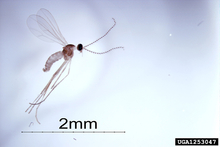Quick facts
- Swede midge is an invasive fly whose larval stage feeds on the growing point of plants in the brassica family, such as broccoli, cauliflower, brussel sprouts, collards and kohlrabi.
- Feeding causes distortion and scarring on leaves and, depending on plant age, will keep heading crops like broccoli from producing a crown, or cause it to grow multiple heads.
- Swede midge was first found in Minnesota in 2016 and has been reported in limited areas in Hennepin and Ramsey counties. It is also established north of the Minnesota border in Manitoba.
- Swede midge is most likely to be an issue in community gardens and on small farms where no pesticides are used.
How to tell Swede midge from other insects
-
Every life stage of a Swede midge is very small, making it unlikely that you will notice them.
-
Adults are around 2mm in size with a delicate body that ranges in color from light brown to light orange.
-
Larvae are 1-4 mm long. They are either a creamy white color (1 mm when young) or a lemon yellow color (3-4 mm when mature). They feed on the growing point of brassicas.
Damage
Damage is often first noticed on the edge of fields or gardens next to buildings or tree lines. This is because Swede midge is moved by wind, making it easy for them to get blown and then grouped into these areas.
Damage occurs when larvae feed on the growing point. This feeding can cause a range of symptoms, including:
- Plants with odd growth pattern and distorted leaves.
- Corky, brown scarring at the base of the stems, leaves, heads, and crowns.
- Multiple stems or crowns.
- Uneven heads.
- Complete loss of head or crown.
Biology
- Swede midge overwinters in the top 1-5 cm of soil, in fields where brassicas were grown previously.
- They can remain dormant for several seasons until they detect the right combination of moisture and heat.
- Adult flies live for approximately 1-5 days, during which time they mate.
- Females lay eggs, and larvae hide and feed in the folds of the growing point for about 7-15 days. Larvae then drop to soil and repeat this process as long as environmental conditions are favorable and host plants are available.
- There can be anywhere from 2 to 5 generations per year, depending on the weather conditions.
Managing Swede midge in home gardens
Correct identification
- Swede midge damage can be hard to diagnose because you may never see the insect itself. Larvae feed on the growing point, which is often protected by leaves.
- The damage caused can resemble that caused by animal feeding, other insects, herbicide injury, and nutrient deficiencies. The key thing to look for is the brown corky scaring near the growing point.
- If you suspect you have Swede midge in your garden, you can report it to the Minnesota Department of Agriculture.
Cultural controls
- Do not start transplants in soil that may be infested with Swede midge pupae.
- If you have confirmed Swede midge in your garden, do not plant brassicas in the same place for 1-3 years. Even taking just one year off from growing brassicas can greatly reduce Swede midge populations.
- Promptly remove crop residue after harvest. Eggs are laid only on growing points, so it is okay to compost these materials.
Managing Swede midge on farms
Monitoring for Swede midge
Sticky traps with pheromone lures can be used to track for Swede midge from the start of the growing season in May through the end of the growing season in October. As little as 5 adult males in a trap per day is enough to determine that midges are breeding. Swede midges are difficult to tell apart from other flies, making traps hard to use.
Cultural controls
- Destroy crop residues promptly after harvesting.
- Practice a 3-year rotation. Distance between fields is important, aim for rotating crops at least 3000 feet away. If fields are separated by woods or other barriers, the distance can be 500 feet.
- Avoid planting crops near known brassica cover crops or weeds, as these often serve as reservoirs for Swede midge.
- Do not use brassica cover crops, as they provide places for Swede midge to reproduce and build their populations.
Physical controls
- If you are rotating, exclusion netting can be placed over high-value crops when Swede midge pressure is high.
Using insecticides
Many products that work on flea beetles and caterpillars work well on Swede midge. For current recommendations, see the Midwest Vegetable Production Guide.
There are currently no effective organic approved insecticides for the control of Swede midge.
Chen, M., & Shelton, A. M. (2007). Impact of Soil Type, Moisture, and Depth on Swede Midge (Diptera: Cecidomyiidae) Pupation and Emergence. In POPULATION ECOLOGY. https://bioone.org/terms-of-use
Chen, M., Shelton, A. M., Hallett, R. H., Hoepting, C. A., Kikkert, J. R., & Wang, P. (2011). Swede midge (Diptera: Cecidomyiidae), ten years of invasion of crucifer crops in North America. Journal of Economic Entomology, 104(3), 709–716. https://doi.org/10.1603/EC10397
Corlay, F., & Boivin, G. (2008). Seasonal Development of an Invasive Exotic Species, Contarinia nasturtii (Diptera: Cecidomyiidae), in Quebec. In Environ. Entomol (Vol. 37, Issue 4). https://academic.oup.com/ee/article/37/4/907/680413
des Marteaux, L. E., & Hallett, R. H. (2019). Swede midge (Diptera: Cecidomyiidae) diapause initiation under stable conditions: Not a family affair. Canadian Entomologist, 151(4), 465–474. https://doi.org/10.4039/tce.2019.33
Elisabeth, A., Yolanda, H., Christine, A., & Rebecca, H. (2017). Organic Management of Swede midge.
C. Hoepting, C., Brake, S. vande, Cornell, C., & Program, V. (2020). Cornell Cooperative Extension Integrated Pest Management VEGETABLE FACT SHEET NEW Crop Rotation Recommendations for Swede Midge.
Stratton, C. A., Hodgdon, E. A., Zuckerman, S. G., Shelton, A. M., & Chen, Y. H. (2018). A single Swede midge (Diptera: Cecidomyiidae) larva can render cauliflower unmarketable. Journal of Insect Science, 18(3). https://doi.org/10.1093/jisesa/iey062
Reviewed in 2022




